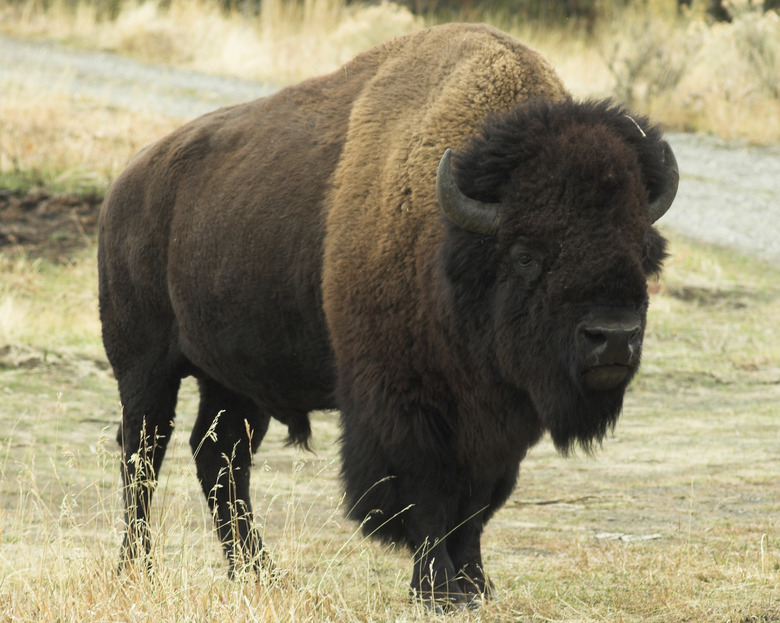List Of The Biggest Land Mammals In The United States
Thomas Jefferson used to boast to European statesmen of the greater dimensions attained by American animals than their Old World counterparts. Though it's not strictly accurate, the claim has an element or two of truth: Several mammals also found in Eurasia reach their maximum size in North America. The mammoths, mastodons and giant short-faced bears of the Pleistocene may be gone, but the United States still has a few colossi among its land mammals: specifically, some jumbo-sized ungulates and a few epic bruins.
Heavyweight Champion: The American Bison
Heavyweight Champion: The American Bison
King of North America's mammals, the American bison is a magnificent bovine, or wild cow, which is widely called the "buffalo," although true buffalo belong to a different genus restricted to the Old World. American bison, which famously nearly went extinct in the 19th and early 20th centuries, but have gradually recovered through devoted conservation efforts, come in two subspecies: the wood bison of northern Canada and Alaska and the plains bison, which once roamed the Great Plains in the millions. While both types are titans, the wood bison — reintroduced to historic United States range in Alaska in 2015 — is the bigger of the two, and also the heftiest land mammal in the Americas: Bulls may exceed 2,000 pounds in weight. Wood bison also have a more forward-pointing hump, whereas the plains bison's peaks directly over the front legs.
The Mighty Moose
The Mighty Moose
A number of subspecies of moose, the biggest member of the deer family, inhabit the animal's vast Northern Hemisphere range, which stretches from Scandinavia to New England. The United States and Canada claim the very largest moose: the Alaska-Yukon subspecies, the bulls of which may weigh in excess of 726 kilograms (1,600 pounds). Besides its sheer bulk, the moose impresses with its lofty stature — it may stand 1.8 meters (6 feet) at the shoulder — and its striking appearance, which includes a bulbous nose, a shoulder hump, and in bulls, a magnificent rack of palmate antlers.
Giant American Bears
Giant American Bears
Alaska can lay claim to the two biggest land carnivores in the world: the polar bear and the Kodiak bear, a subspecies of brown bear restricted to the Kodiak Archipelago of southeastern Alaska. Polar bears may weigh 800 kilograms (1,760 pounds), the largest wild specimen on record being a 1,002-kilogram (2,210-pound) male killed in Alaska's Kotzebue Sound. Kodiaks may weigh at least 680 kilograms (1,500 pounds), though some have allegedly tipped the scales at better than 1,134 kilograms (2,500 pounds). Mainland North American brown bears, or grizzlies, tend to be somewhat smaller, although grizzlies in particularly rich habitats — such as coastal Alaska and British Columbia and, historically, California — can certainly weigh more than half a ton. The more numerous and widespread American black bear, while substantially smaller than the biggest polar and brown bears, is no slouch in the size department: A boar, or male, killed in North Carolina in 1998 weighed 400 kilograms (880 pounds), and even bigger bears are known in captivity.
Heftiest Wapiti: The Roosevelt Elk
Heftiest Wapiti: The Roosevelt Elk
The wapiti is often often called elk, which confusingly, may also refer to the Eurasian moose. It is the second-largest deer in the world, and historically ranged from East Asia through much of North America. The closely related and smaller red deer — sometimes taxonomically lumped together with the wapiti — is widespread from central Asia westward through Europe. North America harbors the biggest wapiti subspecies in the world: the Roosevelt elk, named for U.S. President Theodore Roosevelt. Roosevelt established Mount Olympus National Monument — now Olympic National Park — on Washington's Olympic Peninsula mainly to preserve these dark-coated, shaggy-maned giants. Roosevelt elk, which inhabit the rugged temperate rainforests of the Pacific Northwest, may attain 590 kilograms (1,300 pounds). Despite their greater mass, Roosevelt elk support proportionately smaller and narrower antlers than other North American wapiti — perhaps because broader racks would obstruct them in the heavy timber forests they favor.
Other Big Beasts
Other Big Beasts
Though they resemble wild cattle, such as bison, the muskoxen of northern Alaska are more closely related to goats. They're actually a reintroduced population of these woolly Ice Age beasts, which are also found in northern Canada, Greenland and Eurasia. A bull muskox may weigh 380 kilograms (836 pounds). The woodland caribou, biggest of the North American caribou, is a highly threatened animal mostly restricted to Canada, but small populations do inhabit the United States portion of the Selkirk Mountains in Idaho and Washington, as well as southeastern Alaska's Wrangell-St. Elias region. The largest bulls may be 318 kilograms (700 pounds). Rocky Mountain wapiti are comparable in dimensions.
Cite This Article
MLA
Shaw, Ethan. "List Of The Biggest Land Mammals In The United States" sciencing.com, https://www.sciencing.com/list-biggest-mammals-8317803/. 13 March 2018.
APA
Shaw, Ethan. (2018, March 13). List Of The Biggest Land Mammals In The United States. sciencing.com. Retrieved from https://www.sciencing.com/list-biggest-mammals-8317803/
Chicago
Shaw, Ethan. List Of The Biggest Land Mammals In The United States last modified August 30, 2022. https://www.sciencing.com/list-biggest-mammals-8317803/
